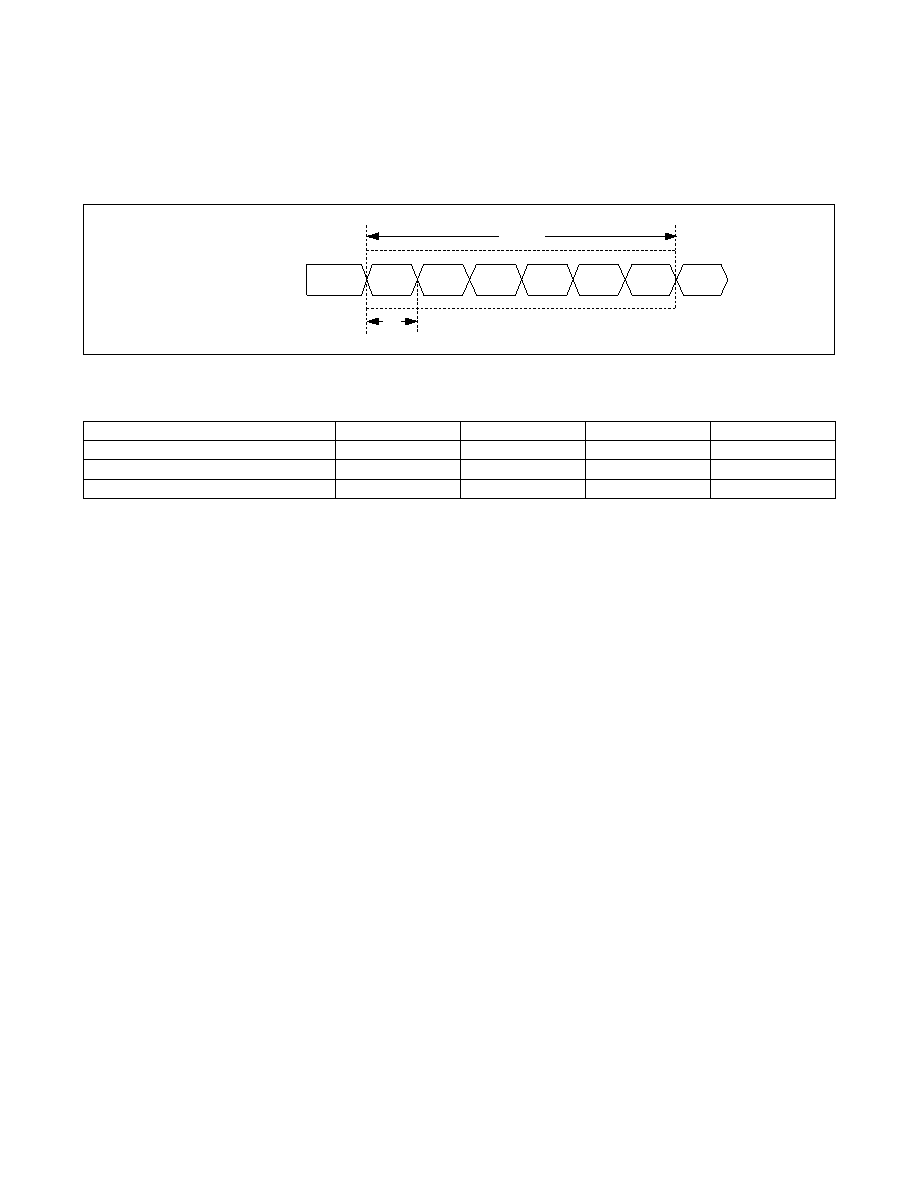- 您現(xiàn)在的位置:買賣IC網(wǎng) > PDF目錄1913 > DS1876T+T&R (Maxim Integrated Products)IC CTRLR SFP DUAL LDD 28TQFN PDF資料下載
參數(shù)資料
| 型號: | DS1876T+T&R |
| 廠商: | Maxim Integrated Products |
| 文件頁數(shù): | 6/69頁 |
| 文件大小: | 0K |
| 描述: | IC CTRLR SFP DUAL LDD 28TQFN |
| 產(chǎn)品培訓(xùn)模塊: | Lead (SnPb) Finish for COTS Obsolescence Mitigation Program |
| 標(biāo)準(zhǔn)包裝: | 2,500 |
| 類型: | SFP 激光控制器 |
| 輸入類型: | 邏輯 |
| 輸出類型: | 邏輯 |
| 接口: | I²C |
| 電流 - 電源: | 10mA |
| 安裝類型: | 表面貼裝 |
| 封裝/外殼: | 28-WFQFN 裸露焊盤 |
| 供應(yīng)商設(shè)備封裝: | 28-TQFN-EP(5x5) |
| 包裝: | 帶卷 (TR) |
第1頁第2頁第3頁第4頁第5頁當(dāng)前第6頁第7頁第8頁第9頁第10頁第11頁第12頁第13頁第14頁第15頁第16頁第17頁第18頁第19頁第20頁第21頁第22頁第23頁第24頁第25頁第26頁第27頁第28頁第29頁第30頁第31頁第32頁第33頁第34頁第35頁第36頁第37頁第38頁第39頁第40頁第41頁第42頁第43頁第44頁第45頁第46頁第47頁第48頁第49頁第50頁第51頁第52頁第53頁第54頁第55頁第56頁第57頁第58頁第59頁第60頁第61頁第62頁第63頁第64頁第65頁第66頁第67頁第68頁第69頁

14
Maxim Integrated
SFP Controller with Dual LDD Interface
DS1876
corresponding alarms and warnings (TXP HI1, TXP LO1,
TXP HI2, TXP LO2, BIAS HI1, and BIAS HI2) are asserted
or deasserted.
After resetting, the device completes one QT cycle
before making comparisons. The TXP LO quick-trip
alarm updates its alarm bit, but does not create FETG
until after TXDEXT. TXP HI and BIAS HI can also be con-
figured to wait for TXDEXT; however, this can be disabled
using QTHEXT_ (Table 02h, Register 88h).
Monitors and Fault Detection
Monitors
Monitoring functions on the DS1876 include six quick-
trip comparators and six ADC channels. This monitoring
combined with the alarm enables (Table 01h/05h) deter-
mines when/if the DS1876 turns off DACs and triggers
the TXFOUT and TXDOUT1, TXDOUT2 outputs. All the
monitoring levels and interrupt masks are user program-
mable.
Six Quick-Trip Monitors and Alarms
Six quick-trip monitors are provided to detect potential
laser safety issues and LOS status. These monitor the
following:
1) High Bias Current 1 (HBATH1), causing QT BIAS1 HI
2) Low Transmit Power 1 (LTXP1), causing QT TXP1 LO
3) High Transmit Power 1 (HTXP1), causing QT TXP1 HI
4) High Bias Current 2 (HBATH2), causing QT BIAS2 HI
5) Low Transmit Power 2 (LTXP2), causing QT TXP2 LO
6) High Transmit Power 2 (HTXP2), causing QT TXP2 HI
The high and low transmit power quick-trip registers
(HTXP1, HTXP2, LTXP1, and LTXP2) set the thresholds
used to compare against the PMON1 and PMON2 volt-
ages to determine if the transmit power is within speci-
fication. The HBATH1 and HBATH2 QTs compare the
BMON1 and BMON2 inputs (generally from the laser
driver’s bias monitor output) against their threshold set-
tings to determine if the present bias current is above
specification. The bias and power QTs are routed to
FETG through interrupt masks to allow combinations
of these alarms to be used to trigger FETG. The bias
and power QTs are directly connected to TXFOUT (see
Figure 9). The user can program up to eight different
temperature-indexed threshold levels for HBATH1 and
HBATH2 (Table 06h, Registers E0h
-E7h).
Six ADC Monitors and Alarms
The ADC monitors six channels that measure tem-
perature (internal temp sensor), VCC, PMON1, PMON2,
BMON1, and BMON2 using an analog multiplexer to
measure them round-robin with a single ADC (see the
ADC Timing section). The channels have a customer-
programmable full-scale range, and all channels have a
customer-programmable offset value that is factory pro-
grammed to a default value (see Table 2). Additionally,
PMON1, PMON2 and BMON1, BMON2 can right-shift
results by up to 7 bits before the results are compared
to alarm thresholds or read over the I2C bus. This allows
customers with specified ADC ranges to calibrate the
ADC full scale to a factor of 1/2n of their specified range
to measure small signals. The DS1876 can then right-
shift the results by n bits to maintain the bit weight of their
specification.
Figure 3. Quick-Trip Sample Timing
Table 2. ADC Default Monitor Full-Scale Ranges
QUICK-TRIP SAMPLE TIMES
LTXP2
SAMPLE
HBIAS1
SAMPLE
HBIAS1
SAMPLE
HBIAS2
SAMPLE
HTXP1
SAMPLE
HTXP2
SAMPLE
LTXP1
SAMPLE
LTXP2
SAMPLE
tREP
QT CYCLE
SIGNAL (UNITS)
+FS SIGNAL
+FS HEX
-FS SIGNAL
-FS HEX
Temperature (NC)
127.996
7FFF
-128
8000
VCC (V)
6.5528
FFF8
0
0000
PMON1, PMON2 and BMON1, BMON2 (V)
2.4997
FFF8
0
0000
相關(guān)PDF資料 |
PDF描述 |
|---|---|
| DS1877T+T&R | IC CTLR/MON SFP 1-2CH 28TQFN |
| DS1878T+T&R | IC CTLR SFP W/DGTL LDD RX 28TQFN |
| DS1881Z-050+T&R | IC DGTL POT NV 2CH 45K 16-SOIC |
| DS1882Z-050+T&R | IC POT DIGIT DL LOG 50K 16SOIC |
| DS1884AT+T | IC SFP PON ONU CTRLR 24TQFN |
相關(guān)代理商/技術(shù)參數(shù) |
參數(shù)描述 |
|---|---|
| DS1877 | 制造商:MAXIM 制造商全稱:Maxim Integrated Products 功能描述:SFP Controller for Dual Rx Interface |
| DS1877T+ | 功能描述:ADC / DAC多通道 SFP+ Controller w/ Dual RX Interface RoHS:否 制造商:Texas Instruments 轉(zhuǎn)換速率: 分辨率:8 bit 接口類型:SPI 電壓參考: 電源電壓-最大:3.6 V 電源電壓-最小:2 V 最大工作溫度:+ 85 C 安裝風(fēng)格:SMD/SMT 封裝 / 箱體:VQFN-40 |
| DS1877T+T&R | 制造商:Maxim Integrated Products 功能描述:SFP CTRLR FOR DUAL RX INTERFACE TQF - Tape and Reel 制造商:Maxim Integrated Products 功能描述:IC CTLR/MON SFP 1-2CH 28TQFN |
| DS1877T+T&R | 功能描述:ADC / DAC多通道 SFP+ Controller w/ Dual RX Interface RoHS:否 制造商:Texas Instruments 轉(zhuǎn)換速率: 分辨率:8 bit 接口類型:SPI 電壓參考: 電源電壓-最大:3.6 V 電源電壓-最小:2 V 最大工作溫度:+ 85 C 安裝風(fēng)格:SMD/SMT 封裝 / 箱體:VQFN-40 |
| DS1877T+TR | 制造商:MAXIM 制造商全稱:Maxim Integrated Products 功能描述:SFP Controller for Dual Rx Interface |
發(fā)布緊急采購,3分鐘左右您將得到回復(fù)。